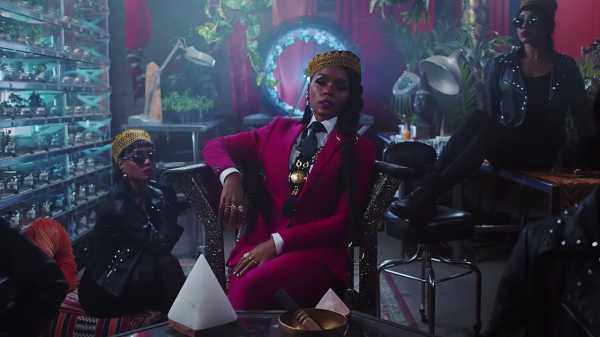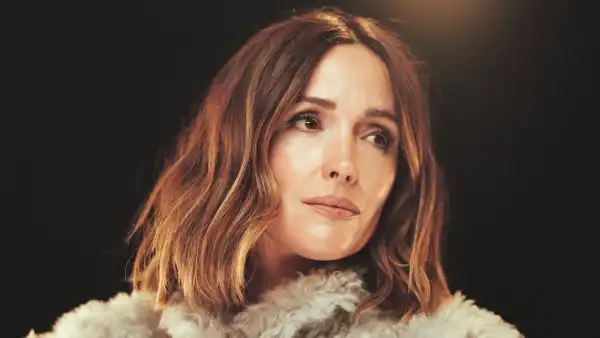
The concept album is an extravagant obfuscation of what we imagine as
the artist’s “self”—think of Pink Floyd’s comments on sanity in “The
Dark Side of the Moon”; David Bowie adopting the costume of the alien
androgyne Ziggy Stardust; George Clinton, the human kaleidoscope, and
the extensive Funkadelic “Mothership” mythology. Historically, the
concept album has suggested a detour in an artist’s œuvre, a one-off
production that lands with attendant visuals, loaded with literary,
cinematic, and historical references. (Set pieces from the Wu-Tang Clan
have even spawned ancillary comics.) But the form has lately become a
vaguer thing, and a requirement for the famous-beyond-comprehension
artist, who, by performing some kind of thematic fiction, also performs
an intimate reveal. When, in the cartoon video for the single “The Story
of O. J.,” Jay-Z appears as the exasperated Jaybo, an update to the big-lipped Sambo, he wants us to remember that moguldom brings misery.
The thirty-two-year-old artist Janelle Monáe has taken the concept album
to complex heights; by now, the most surprising thing she could do would
be to perform as herself. A charismatic actor as well as a musician—her
turns in “Hidden Figures” and “Moonlight” were quietly expert—she is
cinematic in whatever she does. “Django, never Sambo,” she brags on the
single “Django Jane,” one of two newly released tracks (with
accompanying videos) from her forthcoming album, “Dirty Computer.” She
calls her albums “emotion pictures,” and, consumed chronologically, the
Monáe suite makes up a sparkling, occasionally convoluted space
hip-hopera, inspired by Fritz Lang’s Marxist epic “Metropolis,” from
1927. Since her début EP, “Metropolis: Suite 1 (The Chase),” released in
2007, Monáe has performed as the post-human Cindi Mayweather—a
“rock-star proficient” android who falls in love with the human Anthony
Greendown. Dense liner notes and interjecting overtures on her projects
describe a dystopia apparently of her own design: the literature from
“The Electric Lady,” her 2013 album, tells us that “Janelle Monáe, Palace of
the Dogs Patient #57821,” has received “secret compositions conveyed to
her by the android hero Cindi Mayweather.” In interviews, Monáe
sometimes speaks as Cindi, at once evading and inviting questions. “The
lesbian community has tried to claim me, but I only date androids,” she
said, deadpan, to Rolling Stone, in 2010.
For a decade, Monáe has been a spokesperson: for black victims of police
brutality, on her 2015 protest song “Hell You Talmbout”; for the
independence of women artists, at the Grammys this January; for
CoverGirl, since 2012, in commercials where her smiling, heart-shaped
face looks like a post-Internet beauty ideal as created by an algorithm.
And yet Monáe’s opaque mythmaking has also been met with some justified
side-eyes, and some tedious crowing about black female authenticity. Was
this suit-wearing, pompadour-crowned futurist a package masterminded by
her label, Bad Boy Records, or a real soul prodigy?
Monáe—who for years performed in a “uniform,” variations of a
black-and-white suit—grew up in Kansas City. Her father worked as a
sanitation worker and her mother as a janitor. In high school, she wrote
musicals—one about the miracles of photosynthesis, based on Stevie
Wonder’s album “Journey Through the Secret Life of Plants,” from 1979.
In Atlanta, just shy of her twenties, she worked at an Office Depot to
finance her demo, “Audition,” which she self-released, in 2003. Atlanta’s
ATLien futurists André 3000 and Big Boi both raved over her talent, and
the latter ended up executive-producing “Metropolis.” What became clear,
after the releases of “The ArchAndroid,” in 2010, and “Electric Lady,”
in 2013, and after Monáe co-founded her own label and collective,
WondaLand Arts Society, was the depth of her cultural and musical
immersion. Monáe’s albums are passionate studies of the prophecies of
Octavia Butler, the radical social criticism of Wonder, the lurching
outsiderism of Bowie.
The risk of art pop is that the mélange will overpower the music.
Monáe’s alien visions have sometimes felt like a de-rigueur,
Afrofuturist pastiche. But when the balance is right—in the fists-up
exhilaration of “Cold War,” or the “Total Eclipse of the Heart”-esque
pining of “Primetime”—the formula is winning. Monáe sings; she raps; she
dances; she writes. At the Boston House of Blues, in 2013, the night
that the City Council declared October 16th “Janelle Monáe Day,” for
her social activism, I watched the five-foot-tall artist complete a
course of choreography that was more like a chain of stunts, all while
maintaining an unnervingly spectacular vocal tone. Plenty of pop stars
have incorporated Donna Haraway’s idea of the female cyborg, its
indomitability, its performance and evasion of gender, into their
aesthetics; Monáe is one of the few to give life to its perfection. A
couple of summers ago, performing alongside the fellow-dandy Jidenna, her Wondaland label-mate, she oozed P-Funk intuition, barely pausing to
breathe.
In 2010, after Monáe sent her album “The ArchAndroid” to Prince and
Wonder for their opinions, Prince sought her out, becoming a mentor. He
contributed to “Electric Lady” and, posthumously, provides the synth
line on “Make Me Feel,” the stronger of the two singles from “Dirty
Computer.” Like her idol, Monáe is a traditional showperson, hugely
conscious of the power of symbol. Hers is the purest interpretation of
the pop star as cipher—a human on whom misfits of race, of love, and of
gender can project their own aspirational fictions. We’ve endured the
titillations of Katy Perry kissing a girl, Madonna making out with
Britney Spears, and Christina Aguilera on the V.M.A. stage. But Monáe’s
response to the “speak your truth” dictate—the idea that artists are
polemicists who must reveal whatever makes them “real”—continues to
captivate. She won’t answer questions about her sexuality in interviews,
but in “Q.U.E.E.N.,” from “Electric Lady,” on which Monáe sings with
Erykah Badu (whose own concept album involved embodying Lady
“Amerykah”), Monáe teases, “Say, is it weird to like the way she wear
her tights?” In the trailer for her latest “emotion picture,” released
earlier this month, we see Monáe in the arms of two lovers, one man, one
woman. Monáe’s personae draw on artists, from Bessie Smith to Freddie
Mercury, who have communicated through metaphor, for self-protection,
and through camp, for glamour.
It’s the video for “Make Me Feel,” her version of Prince’s conversation
starter “Controversy,” that has caused the real stir online. “This is
pure, unadulterated black bisexual happiness,” a writer for Autostraddle, a queer feminist Web site, wrote. Until now, Monáe’s universe has only
obliquely featured sex; “Make Me Feel” is, to quote the lyrics, “an
emotional, sexual bender,” “powerful with a little bit of tender.” Erotic
strokes of guitar come in, accompanied by heavy whimpers. There’s
nothing robotic in this scenario: in the video, the thinker’s pop star
is all messy urges, prowling through a phalanx of swaying female legs.
She grows crazed choosing between a male and a female paramour (the
latter played by the actress Tessa Thompson). The critic Sasha Geffen
beautifully identified the blue and magenta of the video as “bisexual
lighting”:
“She plays multiple characters and checks herself out, a visual
representation of the queer confusion that arises when you’re not sure
whether you want to sleep with someone or become them, or both,” Geffen
wrote. The video could have been Monáe’s coming out—sexually,
artistically—but she remains her own hall of mirrors. I’m eager to see
her next reflection.
Sourse: newyorker.com






